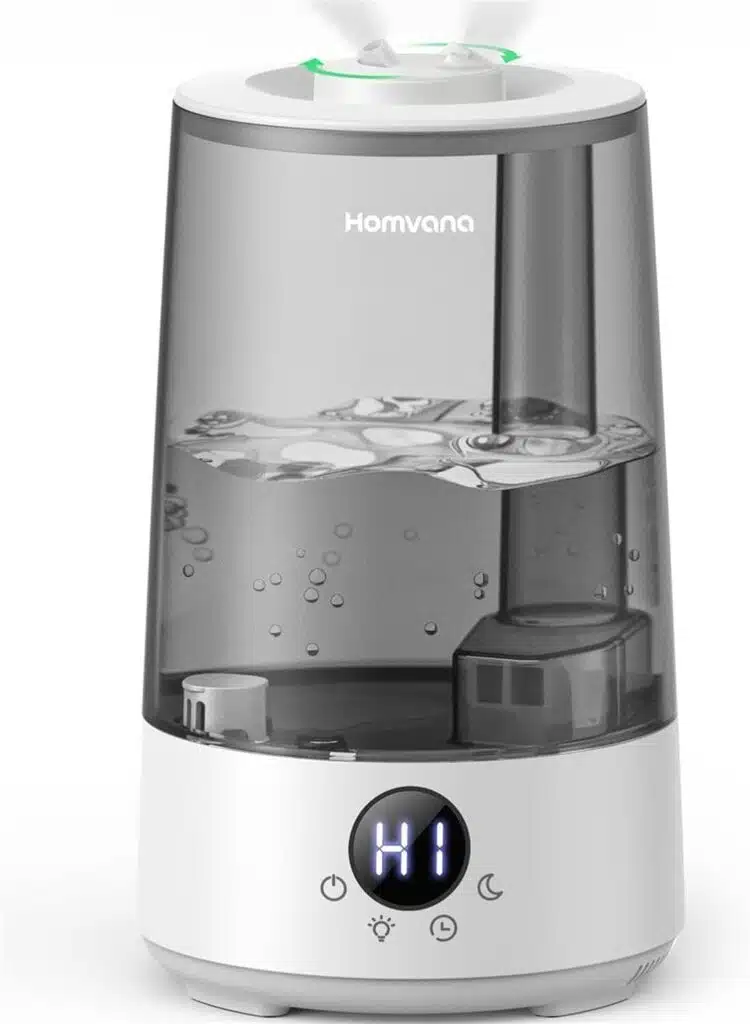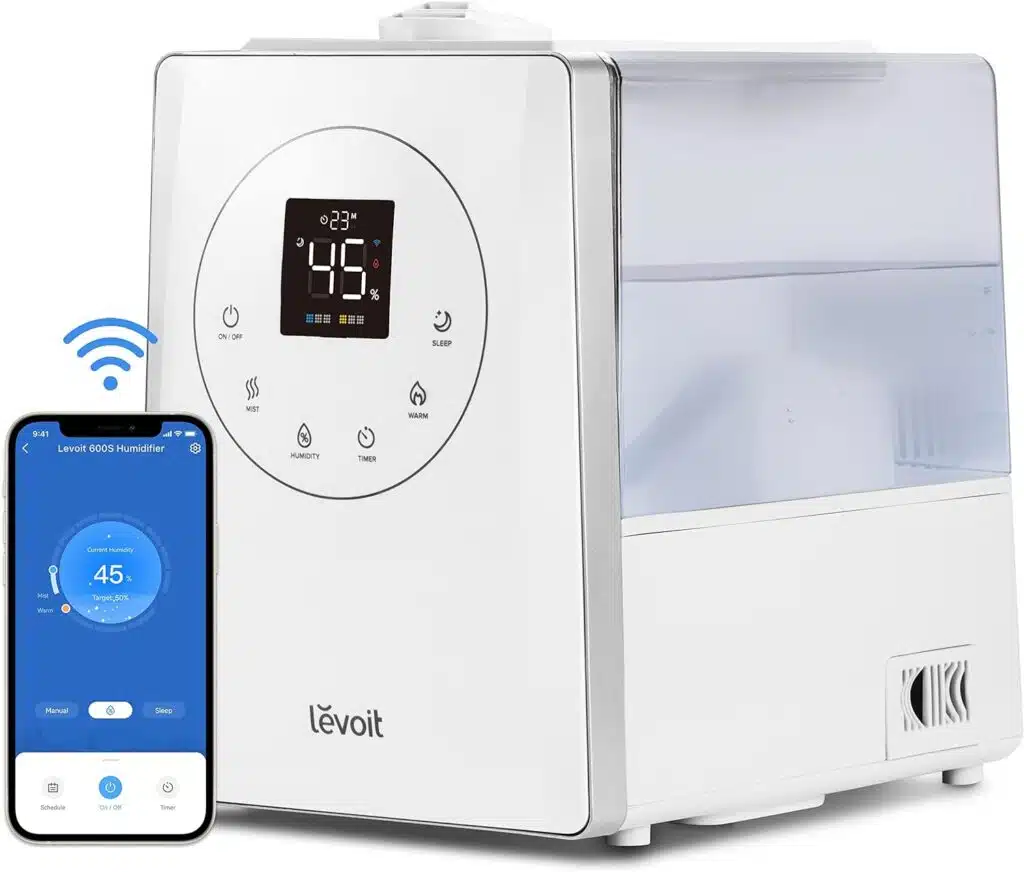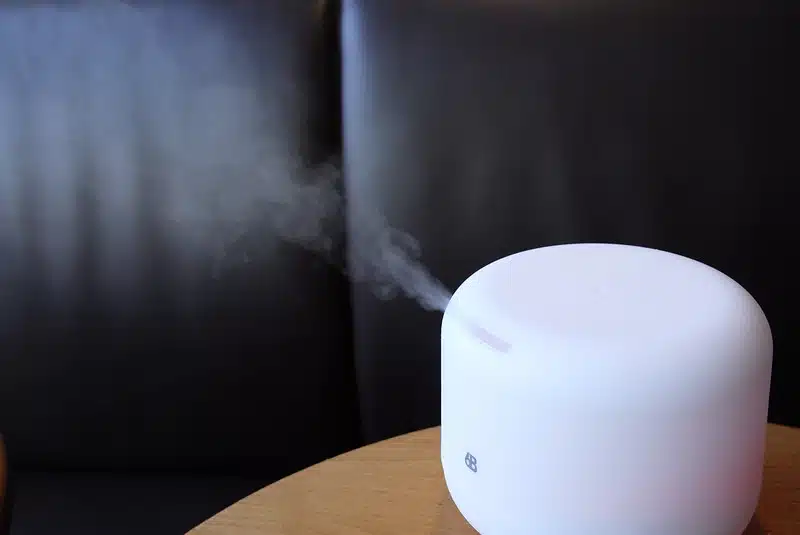Have you ever walked into the tropical area of a garden centre and been hit with a wave of humid heat? I remember doing exactly that and wondering how on earth they got it to be so humid, so consistently, over such a large area.
In retrospect, though I couldn’t see any at the time, it was likely due to time-automated misters or sprinklers. My understanding is that commercial grow-houses use a computerized system in conjunction with a hygrometer (a device used to measure humidity) to automatically adjust levels when needed.
Picking a Humidifier
Unfortunately, we don’t have such luxuries. I was prompted to research ways in which I could increase humidity around house-plants after becoming a little depressed at the state of my orchids. I’d positioned them on a “humidity tray” (pebbles and water) along with a maidenhair fern but, despite frequent watering, they looked markedly sad and droopy. The maidenhair itself more or less died (I say more or less because there’s still a few straggly frond hanging on).
So I decided to invest in a humidifier. Before doing so, however, I did some fairly in-depth research into the various types and models, learning about the benefits of each along the way. So that, alongside my favourite picks, is what I’ve presented here. I’ve listed my buying choices first then offered some general advice about what to look for. If you’re concerned, for instance, about the difference between an ultrasonic and a warm-mist humidifier and what effect each will have on your plants, or worried about peeling wallpaper and damp patches on the floor, then read this section first.
The Short Version: Best Humidifiers for Plants
- Homvana Cool Mist Humidifier (££) (Top Pick)
- Wicks Warm Mist Humidifier (££)
- Levoit Smart Humidifier (£££)
- Vintoney 500ml Humidifier (£) (Low-Price Option)
Our Best Humidifier Picks for 2024
I imagine that most people will be looking for a humidifier to help with their house plants. It’s worth mentioning that they can also be useful for those people starting seedlings indoors (I’m thinking in particular of city gardeners), where sprouting will be more successful in a slightly moist environment.
If you’re looking to humidify a greenhouse, then you’re better off seeking out a system of sprinklers or a fogger. The selections here will largely be counter-productive to what you’re trying to achieve.
What I’m looking for…
We’re looking for a few things. The first is a decent running capacity, in excess of twelve hours and ideally of twenty-four or more. If you’re using these to aid plants then you’ll want them running for a period of at least twelve hours throughout the day, with the plants placed in the immediate area where humidity is going to be highest. Second, and this again relates to our intended near-continuous use, we want a relatively simple piece of kit that we can easily take apart and clean every few months (see below for more cleaning tips). Finally, it needs to be compact and decent(ish) looking when it’s nestled amongst the plants.
1. Homvana Cool Mist Humidifier

This Homvana model is a cool-mist humidifier that’s perfect for plants. It’s well-priced, quiet and lasts 34 hours on a single fill, which is better than many other models I’ve looked at. It also has a night light in seven colours.
The plastic chamber, which has a 3.6 litre capacity, is detachable and easy to clean. It fills from the top which is very straightforward.
This hits many of the requirements for a humidifier for plants and, given the large tank capacity, you can set the timer and leave it for several days. If noise is an issue, this is definitely the one to go for.
2. Vicks Warm Mist Humidifier

This is an inexpensive and robust option for those who want to increase humidity without spending too much money. It’s intended use is for the relief of cold and flu symptoms (you can have it handy if you get a runny nose) but it works perfectly fine for plants, especially those tropical ones with a preference for warmth. Remember that most humidifiers (including this one) will have a cooling chamber, so you’re not releasing boiling hot water vapour.
In terms of specifications, it has a one 3.8 litre tank which allows for 24 hours of continuous running, alongside an “automatic shut-off (it will turn itself off when it’s out of steam). There are two settings, high and low, and the noise level for both is minimal.
There are four main components and it’s incredibly easy to set up and clean. All in all this is incredibly well-priced for what you get and a good starter humidifier. It comes with a two-year warranty, so you should be good for at least that long.
3. Levoit LV600S Smart Humidifier

If you’re looking for a larger unit that comes with all the bells and whistles, the Levoit Smart Humidifier will likely have everything you’re looking for.
It has both cool and warm settings, an essential oil diffuser (if you need it) and three speed settings for cool mist. You can also control these settings from an app.
One of the standout features is the auto-adjuster which turns the humidifier on or off based on room humidity levels. If you know the ideal humidity level of a plant or set of plants, this is an extremely useful feature.
If you’re on the lookout for a humidifier for for a larger room and that can be controlled remotely via your phone, this model is well worth considering.
4. Vintoney 500ml Humidifier

I’ve not found a better model under £20 than the Vintoney 500ml humidifier. It doesn’t have the features that you’ll find in more expensive models (like LED lights and remote controls) but it will do the job well enough.
It has a runtime of approximately ten to fifteen hours and has an automatic shut-off. To keep it running continuously, you’ll need to replace it daily. There are three mist settings (intermittent, continuous and light).
On the downside there isn’t any LED light. That said, a very good unit for the price. Placed next to a cluster of plants on a windowsill or similar location it will work perfectly.
More Advice: Just What is Humidity?
Humidity is a measure of the amount of water vapour (H2O in its gaseous form) in the air. There are two terms that correspond to this measurement – relative and absolute. Relative humidity is a comparative measure of the current saturation of air in a particular space (how much vapour it’s holding) in relation to how much it could hold at a given temperature. Absolute humidity is a weight-based measurement of water per cubic metre of air. So relative humidity is essentially a ratio of absolute humidity to saturation-point humidity expressed as a percentage.
Hotter air is able to “hold” more water vapour. The tropical rainforests from where many house-plants originated are both hot and wet – resulting in a very high level of humidity. If you look at pictures of the forest floor, there’s often a light layer of fog, which occurs when the air at ground-level is near 100% relative humidity (also called the dew point). It just goes to show the kind of environment these plants prefer! In comparison, places with very hot air but low water availability (Sahara) or those with cool air but high water availability (Antarctic) will have very low humidity.
As an interesting side note, there’s a common myth that warmer air is able to hold more water because the respective air molecules are moving faster and so create more space for the vapour to “enter”. The reason that there is more evaporation, and so greater humidity, when temperatures are higher is because, alongside warming the air molecules, the heat also warms whatever water molecules are present in the environment. So it’s actually technically wrong (though I know I’ve used the word above) to say that hotter air can “hold” more water. Anyhow, that’s enough science for the evening…
Why bother changing it?
There are a few reasons why high humidity can be so important for certain types of plants. The main one is that many have adaptations which cause them to require a low rate of transpiration – water evaporation – from their leaves. Take my already-mentioned maidenhair fern for instance. The leaves are almost paper-like, very thin and delicate. There’s very little water-holding capacity in the leaves themselves so every little drop needs to be held onto. Remember that orchids, too, are epiphytes so don’t have any roots from which to draw water from the ground. The lower rate of transpiration due to the high humidity – greater vapour saturation of air increases the pressure which water molecules have to overcome in order to evaporate – also allows plants take in carbon dioxide (for photosynthesis) without the risk of heavy water loss (evaporation occurs when the stomata open).
Where tropical and subtropical plants have overcome their transpiration problem by utilizing the water-saturated air, cacti have gotten rid of their leaves entirely (the needles are leaves). What you see as a result is a rather hefty, moisture-filled stem…good old cacti.
What level should I be aiming for?
With all plants it depends. Orchids for instance, prefer humidity in the 40% – 70% range whilst ferns prefer 40% to 50%. The information for specific types is usually readily available online.
Make sure you get a hygrometer, or a thermometer with a humidity measurement included.
Picking and Using a Humidifier for House-Plants
Here are few tips for using humidifiers with plants.
My preferred set-up…
It’s important that you couple your humidifying efforts with appropriate steps to increase airflow around your plant(s)! (I hope the bold and the exclamation mark emphasises the importance of that point…!). I’ve been banging on about the necessity of proper airflow for indoor-grown veggies for a while, and far better gardeners that I have been banging on for a great deal longer. You’re asking for mould and diseases, especially when you’re increasing moisture in the air, if you don’t provide at least an open window. I’d heartily ask you to get a fan as the ideal option.
Now this might all seem a tad effort-intensive for growing a few house plants but it really is worth it when those orchids send out their butterfly-blooms, or for the effect of coupling a few delicate ferns with them…it’s like having you’re own rainforest floor (orchids tend to grow higher up in the canopy, but never mind) in your living room.
My preferred set up consists of: (1) a big(ish) pebble tray for catching the moisture from your humidifier, rather than allowing it to end up as a sheen on the floor, (2) a fan for air circulation and (of course), (3) your humidifier.On this I would group together various plants that have a predilection for the conditions your providing.
There are arguments that you’ll be setting yourself up for damp by using any type of humidifier, but you’re essentially creating your own little ecosystem and, given that the model you choose is a small one, there shouldn’t be a problem. You’re not, after all, tacking up a greenhouse spray system up to your ceiling. If you are a bit concerned however, pop them in the bathroom.
The different types…
Warm mist: Probably the most common type of humidifier, warm mist humidifiers heat the water to a high temperature, creating steam. It is sometimes passed through a cooling chamber.
Ultrasonic: These have a very interesting design. They utilize a vibrating diaphragm at the bottom of the water chamber which transfers energy to the water molecules, increasing the rate of evaporation at the surface of the reservoir.
Evaporative: These humidifiers use a fan to create water vapour. Essentially the unit draws water from a tank to saturate a wicking material (imagine if you suspend a towel in water). A fan then pulls dry air through the wicking material (so to continue with the example, imagine placing a fan in front of the towel) adding vapour to the air in the process.
Don’t forget to clean
Ideally you also want to clean any humidifiers at least once a week, especially if you’re using them on a daily basis. This will avoid the build-up of fungus and mould which can potentially be harmful if released into the air. Equally, with warm mist humidifiers, you’ll prevent the build-up of salt deposits.
A commonly-recommended strategy, one that works very well, is to soak the parts that are prone to being effected in vinegar overnight. In our reviews above we’ve selected models that are ideally-suited to this approach.
Does warm or cold mist make a difference?
The short answer is no. Most plants that require high humidity are tropicals so won’t be bothered by the warmer moisture, though the increase in temperature of the space around the plant will likely be marginal even so. Warm mist humidifiers have the added benefit of purifying the water during the evaporation process, meaning that there won’t be any harmful salt deposits left on leaves if you’re using tap water. The one drawback is that the electricity usage tends to be higher.
All of this said, cold-mist humidifiers do have their benefits. The running costs tend to be lower and they’re usually able to run for longer periods of time without the need for refilling.
Have a Look at our Other Reviews
So there you have it! Our favourite humidifiers for plants. If you’re in the market for other gardening tools then be sure to check out our reviews.
Featured image credit: HS You
